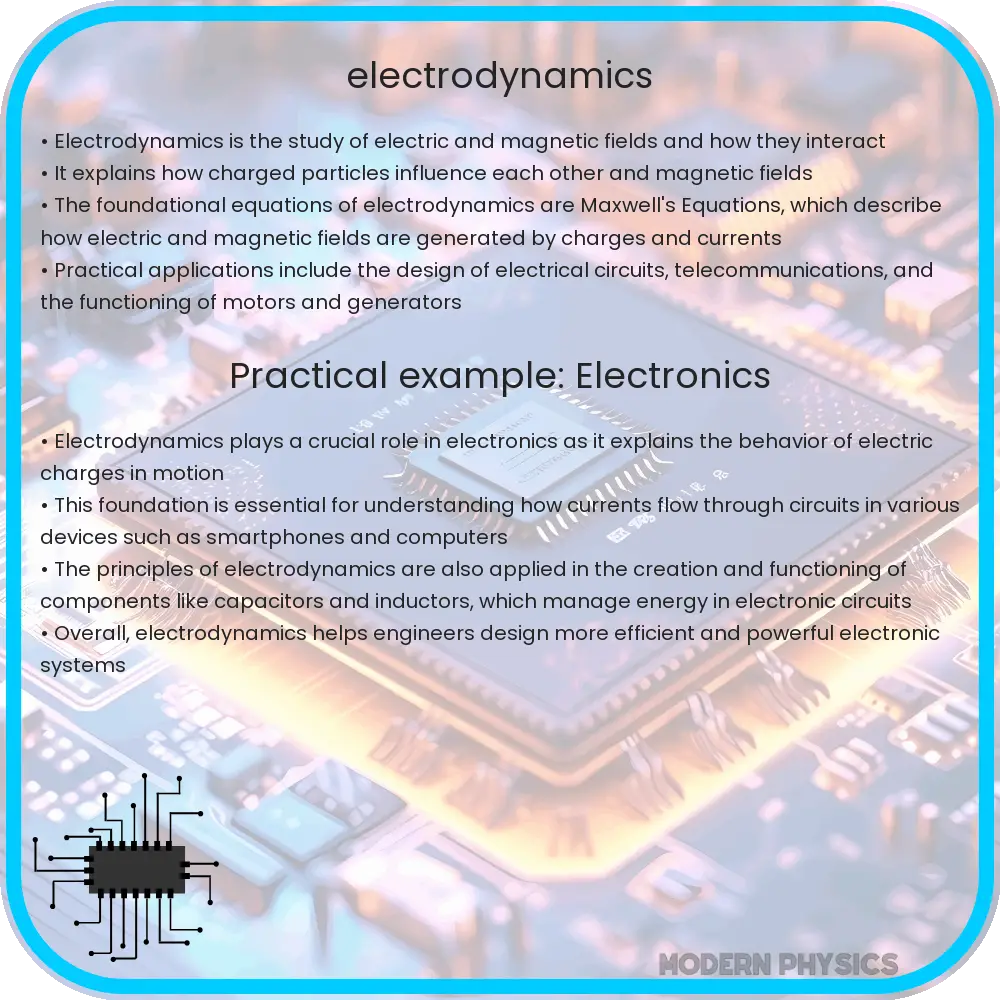Explore the world of electrodynamics, covering its principles, applications, and theoretical aspects, from Maxwell’s equations to quantum electrodynamics.

Understanding Electrodynamics: Fundamentals and Applications
Electrodynamics, a fundamental branch of physics, delves into the study of electric and magnetic fields and their interactions with matter and radiation. It is the theoretical backbone for a wide array of technologies that shape our modern world. This article aims to elucidate the principles, applications, and theoretical aspects of electrodynamics.
Principles of Electrodynamics
At the core of electrodynamics are Maxwell’s equations. These four equations describe how electric and magnetic fields are generated and altered by each other and by charges and currents. They are:
- Gauss’s Law (electric): ∃·E = ρ/ε0, stating the electric field E emanates from electric charges, where ρ is charge density, and ε0 is the electric constant.
- Gauss’s Law (magnetic): ∃·B = 0, indicating that magnetic field lines form closed loops and there are no ‘magnetic charges’ akin to electric charges.
- Faraday’s Law of Induction: ∃×E = -∂B/∂t, which shows how a time-varying magnetic field B generates an electric field.
- Ampère’s Law (with Maxwell’s addition): ∃×B = μ0(J + ε0∂E/∂t), demonstrating how magnetic fields are produced by electric currents J and time-varying electric fields.
These equations not only describe the behavior of electromagnetic fields but also form the foundation for much of modern physics, including quantum mechanics and relativity.
Applications of Electrodynamics
Electrodynamics plays a pivotal role in numerous technological advancements. For instance, it is essential in:
- Communications Technology: Radio waves, a type of electromagnetic radiation, are fundamental to wireless communication.
- Medical Imaging: Techniques like MRI use electromagnetic fields to produce detailed images of the inside of the human body.
- Power Generation and Transmission: Electrodynamics is crucial in the generation of electric power and its transmission over long distances.
The interplay of electric and magnetic fields, as described by electrodynamics, also leads to the phenomenon of electromagnetic waves, which travel through space at the speed of light. This principle is the cornerstone of many forms of modern communication and information technology.
Theoretical Aspects of Electrodynamics
Electrodynamics isn’t just about practical applications; its theoretical dimensions have significantly influenced our understanding of the physical universe. The theory integrates the concepts of fields and quantum mechanics, paving the way for quantum electrodynamics (QED). QED extends classical electrodynamics by incorporating the principles of quantum theory and is used to describe how light and matter interact. It’s one of the most precise models in quantum physics, accurately predicting phenomena at very small scales, like the interaction of electrons and photons.
Electromagnetic Spectrum
One of the remarkable aspects of electrodynamics is the electromagnetic spectrum, encompassing all types of electromagnetic radiation. These range from gamma rays, with very short wavelengths, to radio waves, which have much longer wavelengths. Each part of the spectrum has unique characteristics and applications, such as X-rays in medical diagnostics and infrared radiation in thermal imaging.
Challenges and Future Directions
Despite its widespread applications and theoretical achievements, electrodynamics is not without challenges. One of the ongoing areas of research is the unification of quantum mechanics and general relativity, where classical electrodynamics principles don’t seamlessly integrate. Additionally, the manipulation of electromagnetic fields at nano and quantum scales for advanced computing and communication technologies is a subject of cutting-edge research.
Conclusion
Electrodynamics, with its intricate balance of theoretical depth and practical application, remains a cornerstone of modern physics. From powering our homes to enabling global communication networks, its influence is ubiquitous. As we delve deeper into the quantum realm and strive to unify the fundamental forces of nature, electrodynamics will continue to be a key area of exploration and discovery. Its principles not only light up our homes but also illuminate the path to understanding the universe at its most fundamental level.
